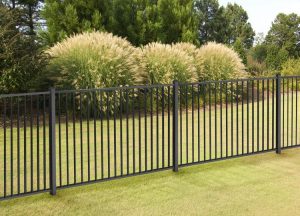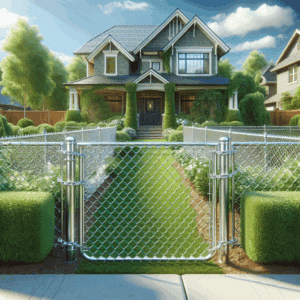Savannah Gate & Fence is here to guide you through the process of installing your very own white Vinyl Fence. If you’ve ever faced challenges with maintaining your privacy and security, this article is your ultimate guide. With our expertise, homeowners like you in Savannah, GA, and the surrounding cities can confidently tackle this task. Learn how to transform your yard and elevate its appearance with our step-by-step instructions.
Contents
- 1 Understanding Your Vinyl Fence
- 2 Gathering Your Tools and Materials
- 3 Preparing Your Yard
- 4 Planning Post Placement
- 5 Digging and Setting the Posts
- 6 Attaching the Fence Panels
- 7 Securing the Gate
- 8 Five Key Installation Tips
- 9 Adding Finishing Touches
- 10 Maintaining Your Vinyl Fence
- 11 Reach Out for Professional Assistance
- 12 Contact Us Today
Understanding Your Vinyl Fence
Before diving into installation, it’s important to understand what makes a vinyl fence a fantastic choice. Vinyl fences are known for their durability, low maintenance, and clean aesthetic. Unlike wood or metal, vinyl doesn’t rot or rust, making it a long-lasting option.
Moreover, vinyl fences are available in a variety of styles and heights, allowing for customization to fit your needs. They blend seamlessly with different home exteriors, providing both functionality and curb appeal.
Gathering Your Tools and Materials
Getting organized is the first step towards a successful installation. You’ll need specific tools and materials to ensure everything comes together smoothly. Making a checklist of these items will save you time and effort.
Common tools include a post-hole digger, level, tape measure, and drill. Of course, don’t forget the vinyl fence panels and posts themselves, along with concrete for stability.
Preparing Your Yard
Preparation is key to avoiding hurdles during installation. Begin by marking the boundary where you want the fence to be installed with stakes and string lines. This will help you visualize the final product and make adjustments as needed.
Remember to check for any underground utilities before you start digging. You can easily avoid safety hazards by contacting your local utility companies for guidance on safe digging practices.
Planning Post Placement
Proper placement of posts ensures the stability of your fence. Start by marking out where each post will go according to the fence panel’s width. This precision will keep the panels snugly aligned during installation.
Spacing between posts is crucial; too far apart or too close can lead to a weak structure. Aim for consistency to maintain the integrity of your vinyl fence.
Digging and Setting the Posts
Now comes the labor-intensive part — digging the holes for your fence posts. Each hole should be about one-third the height of the post you’re installing for maximum stability. Use your post-hole digger to ensure uniformity in depth and width.
Once the holes are ready, insert the posts and fill each with concrete. Take a moment to use your level to make sure the posts are perfectly upright before the concrete sets.
Attaching the Fence Panels
With posts in place, it’s time to attach the fence panels. Slide each panel into the post slots, ensuring they fit snugly. Alignment is key, so frequently check that the panels are level as you secure them.
Use screws or brackets provided with your vinyl fence kit to firmly attach the panels to the posts. This enhances the strength and durability of your fence.
Securing the Gate
The gate is a crucial component of your fence, allowing for entry and exit. Position your gate with precision, ensuring it’s level and swings freely without obstruction.
Use sturdy hinges and latch mechanisms to support the gate’s weight. Regularly check these fixtures for any signs of wear or movement over time to keep your gate functioning properly.
Five Key Installation Tips
- Double-check measurements: Mistakes in measurements can lead to misaligned posts. Double-check before making any cuts or drilling.
- Maintain even spacing: Consistent spacing between posts ensures your fence’s structural integrity and aesthetic appeal.
- Stabilize with concrete: Use quality concrete to anchor posts securely, especially in areas prone to weather changes.
- Level as you go: Regularly use a level to prevent slanted panels and ensure a professional finish.
- Secure all components: Tighten screws and fittings to avoid wobbly panels and Gates over time.
Adding Finishing Touches
Once the fence is up, it’s time to add some finishing touches. Caps on top of the posts not only add a stylish flair but also prevent water from seeping into the posts. Choose caps that complement the design of your fence for a cohesive look.
Additionally, consider landscaping around your fence. Plants and shrubs can further enhance privacy and aesthetic appeal, making your outdoor space a delight to enjoy.
Maintaining Your Vinyl Fence
Your new fence will require minimal maintenance, which is one of the major perks of opting for vinyl. Regularly hose down your fence to remove dirt and debris. For tougher stains, a gentle scrub with mild soap and water will do the trick.
Stay vigilant about inspecting for any damage or loose components. Early intervention can prevent minor issues from becoming significant problems down the line.
Reach Out for Professional Assistance
If at any point you feel unsure about the installation process, don’t hesitate to Contact Us for help. Our experienced team is ready to guide you through any challenges, ensuring your fence looks pristine and stands strong.
Whether it’s advice, hands-on assistance, or a complete installation service, we’ve got you covered. Let us handle the details so you can sit back and enjoy your beautifully fenced property.
Contact Us Today
If you’re ready to begin your vinyl fence installation, we’re just a call or click away. Reach out by phone at 912-800-0818 or Request a Free Quote. Let’s get started on making your fencing dreams a reality!




